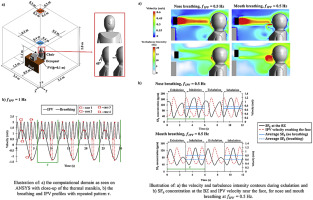当前位置:
X-MOL 学术
›
Build. Environ.
›
论文详情
Our official English website, www.x-mol.net, welcomes your
feedback! (Note: you will need to create a separate account there.)
The effect of human breathing on the effectiveness of intermittent personalized ventilation coupled with mixing ventilation
Building and Environment ( IF 7.1 ) Pub Date : 2020-05-01 , DOI: 10.1016/j.buildenv.2020.106755 Elvire Katramiz , Douaa Al Assaad , Nesreen Ghaddar , Kamel Ghali
Building and Environment ( IF 7.1 ) Pub Date : 2020-05-01 , DOI: 10.1016/j.buildenv.2020.106755 Elvire Katramiz , Douaa Al Assaad , Nesreen Ghaddar , Kamel Ghali

|
Abstract The aim of this work is to study the interaction of human breathing and the intermittent personalized ventilation (IPV) jet and investigate its effectiveness in supplying clean breathable air when operating in relaxed background contaminants’ concentration condition. A transient 3-D computational fluid dynamics (CFD) model of a breathing occupant in an office space equipped with an IPV combined with mixed ventilation system was developed. Two breathing modes were considered: nose breathing and mouth breathing. Tracer gas method was used to evaluate the breathable air quality of the IPV user at different IPV operating frequencies. The flow field resulting from interaction of IPV jet and nose breathing was experimentally validated in a climatic chamber equipped using a breathing thermal manikin. The validated CFD model was used to assess the inhaled air quality at different IPV frequencies in both nose and mouth breathing modes, while comparing it to no-breathing case. It was found that maximum ventilation effectiveness e V ranges during inhalation were obtained at an IPV frequency of 0.5 Hz ranging from 36.75% to 86.6% for nose breathing mode, 49.6%–87.3% for mouth breathing mode and 42.42–86.93% when breathing was not considered. The nose breathing mode gave the lowest e V while the mouth breathing mode gave better e V due to the stronger dilution offered by the horizontally exhaled air. The average e V for the nose and mouth breathing were fairly close to the case of no-breathing and provided satisfactory air quality at the BZ.
中文翻译:

人体呼吸对间歇性个性化通气联合混合通气有效性的影响
摘要 这项工作的目的是研究人类呼吸和间歇性个性化通气 (IPV) 射流的相互作用,并研究其在宽松的背景污染物浓度条件下运行时提供清洁可呼吸空气的有效性。开发了配备 IPV 和混合通风系统的办公空间中呼吸乘员的瞬态 3-D 计算流体动力学 (CFD) 模型。考虑了两种呼吸模式:鼻子呼吸和嘴呼吸。示踪气体方法用于评估 IPV 用户在不同 IPV 操作频率下的可呼吸空气质量。IPV 射流和鼻子呼吸相互作用产生的流场在配备有呼吸热模型的气候室中进行了实验验证。经验证的 CFD 模型用于评估在鼻子和嘴巴呼吸模式下不同 IPV 频率下的吸入空气质量,同时将其与无呼吸情况进行比较。结果发现,在 0.5 Hz 的 IPV 频率下,吸入过程中获得的最大通气效率 e V 范围为鼻呼吸模式的 36.75% 至 86.6%、口呼吸模式的 49.6% 至 87.3% 和呼吸时的 42.42-86.93%不考虑。由于水平呼出的空气提供了更强的稀释,鼻子呼吸模式给出了最低的 e V,而口呼吸模式给出了更好的 e V。鼻子和嘴巴呼吸的平均 e V 相当接近无呼吸的情况,并且在 BZ 提供了令人满意的空气质量。同时将其与不呼吸的情况进行比较。结果发现,在 0.5 Hz 的 IPV 频率下,吸入过程中获得的最大通气效率 e V 范围为鼻呼吸模式的 36.75% 至 86.6%、口呼吸模式的 49.6% 至 87.3% 和呼吸时的 42.42-86.93%不考虑。由于水平呼出的空气提供了更强的稀释,鼻子呼吸模式给出了最低的 e V,而口呼吸模式给出了更好的 e V。鼻子和嘴巴呼吸的平均 e V 相当接近无呼吸的情况,并且在 BZ 提供了令人满意的空气质量。同时将其与不呼吸的情况进行比较。结果发现,在 0.5 Hz 的 IPV 频率下,吸入过程中获得的最大通气效率 e V 范围为鼻呼吸模式的 36.75% 至 86.6%、口呼吸模式的 49.6% 至 87.3% 和呼吸时的 42.42-86.93%不考虑。由于水平呼出的空气提供了更强的稀释,鼻子呼吸模式给出了最低的 e V,而口呼吸模式给出了更好的 e V。鼻子和嘴巴呼吸的平均 e V 相当接近无呼吸的情况,并且在 BZ 提供了令人满意的空气质量。不考虑呼吸时为 42–86.93%。由于水平呼出的空气提供了更强的稀释,鼻子呼吸模式给出了最低的 e V,而口呼吸模式给出了更好的 e V。鼻子和嘴巴呼吸的平均 e V 相当接近无呼吸的情况,并且在 BZ 提供了令人满意的空气质量。不考虑呼吸时为 42–86.93%。由于水平呼出的空气提供了更强的稀释,鼻子呼吸模式给出了最低的 e V,而口呼吸模式给出了更好的 e V。鼻子和嘴巴呼吸的平均 e V 相当接近无呼吸的情况,并且在 BZ 提供了令人满意的空气质量。
更新日期:2020-05-01
中文翻译:

人体呼吸对间歇性个性化通气联合混合通气有效性的影响
摘要 这项工作的目的是研究人类呼吸和间歇性个性化通气 (IPV) 射流的相互作用,并研究其在宽松的背景污染物浓度条件下运行时提供清洁可呼吸空气的有效性。开发了配备 IPV 和混合通风系统的办公空间中呼吸乘员的瞬态 3-D 计算流体动力学 (CFD) 模型。考虑了两种呼吸模式:鼻子呼吸和嘴呼吸。示踪气体方法用于评估 IPV 用户在不同 IPV 操作频率下的可呼吸空气质量。IPV 射流和鼻子呼吸相互作用产生的流场在配备有呼吸热模型的气候室中进行了实验验证。经验证的 CFD 模型用于评估在鼻子和嘴巴呼吸模式下不同 IPV 频率下的吸入空气质量,同时将其与无呼吸情况进行比较。结果发现,在 0.5 Hz 的 IPV 频率下,吸入过程中获得的最大通气效率 e V 范围为鼻呼吸模式的 36.75% 至 86.6%、口呼吸模式的 49.6% 至 87.3% 和呼吸时的 42.42-86.93%不考虑。由于水平呼出的空气提供了更强的稀释,鼻子呼吸模式给出了最低的 e V,而口呼吸模式给出了更好的 e V。鼻子和嘴巴呼吸的平均 e V 相当接近无呼吸的情况,并且在 BZ 提供了令人满意的空气质量。同时将其与不呼吸的情况进行比较。结果发现,在 0.5 Hz 的 IPV 频率下,吸入过程中获得的最大通气效率 e V 范围为鼻呼吸模式的 36.75% 至 86.6%、口呼吸模式的 49.6% 至 87.3% 和呼吸时的 42.42-86.93%不考虑。由于水平呼出的空气提供了更强的稀释,鼻子呼吸模式给出了最低的 e V,而口呼吸模式给出了更好的 e V。鼻子和嘴巴呼吸的平均 e V 相当接近无呼吸的情况,并且在 BZ 提供了令人满意的空气质量。同时将其与不呼吸的情况进行比较。结果发现,在 0.5 Hz 的 IPV 频率下,吸入过程中获得的最大通气效率 e V 范围为鼻呼吸模式的 36.75% 至 86.6%、口呼吸模式的 49.6% 至 87.3% 和呼吸时的 42.42-86.93%不考虑。由于水平呼出的空气提供了更强的稀释,鼻子呼吸模式给出了最低的 e V,而口呼吸模式给出了更好的 e V。鼻子和嘴巴呼吸的平均 e V 相当接近无呼吸的情况,并且在 BZ 提供了令人满意的空气质量。不考虑呼吸时为 42–86.93%。由于水平呼出的空气提供了更强的稀释,鼻子呼吸模式给出了最低的 e V,而口呼吸模式给出了更好的 e V。鼻子和嘴巴呼吸的平均 e V 相当接近无呼吸的情况,并且在 BZ 提供了令人满意的空气质量。不考虑呼吸时为 42–86.93%。由于水平呼出的空气提供了更强的稀释,鼻子呼吸模式给出了最低的 e V,而口呼吸模式给出了更好的 e V。鼻子和嘴巴呼吸的平均 e V 相当接近无呼吸的情况,并且在 BZ 提供了令人满意的空气质量。










































 京公网安备 11010802027423号
京公网安备 11010802027423号